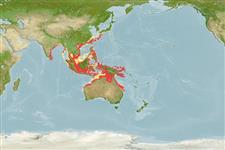Lớp phụ Cá sụn (cá mập và cá đuối) (sharks and rays) >
Orectolobiformes (Carpet sharks) >
Hemiscylliidae (Bamboo sharks)
Etymology: Chiloscyllium: cheilos (Gr.), lip, referring to membranous and broad lower lip, presumably of C. plagiosum (proposed without a species); skylion, Greek for dogfish or small shark. (See ETYFish); punctatum: Latin for spotted, referring to scattering of small blackish spots on young specimens. (See ETYFish).
More on authors: Müller & Henle.
Environment: milieu / climate zone / depth range / distribution range
Sinh thái học
Biển Cùng sống ở rạn san hô; Mức độ sâu 0 - 85 m (Ref. 43278). Tropical; 34°N - 26°S, 78°E - 155°E
Indo-West Pacific: Andaman Island and India east to Philippines, north to Japan and south to Australia.
Length at first maturity / Bộ gần gũi / Khối lượng (Trọng lượng) / Age
Maturity: Lm ?, range 87 - ? cm
Max length : 132 cm TL con đực/không giới tính; (Ref. 106604)
Các tia vây lưng cứng (tổng cộng): 0; Các vây lưng mềm (tổng cộng): 0; Tia cứng vây hậu môn 0; Tia mềm vây hậu môn: 0. Genus: Nostrils subterminal on snout; pre-oral snout long, mouth closer to eyes than snout tip; eyes and supraorbital ridges hardly elevated; no black hood on head or large spot or spots on sides of body above pectoral fins (Ref. 43278). Caudal fin with a pronounced subterminal notch but without a ventral lobe (Ref. 13575).
Species: Young with dark transverse bands and usually a scattering of a few dark spots, bars not prominently edged with black (Ref. 13575, 43278). Adults light-brown, usually without a color pattern (Ref. 13575). Dorsal fins larger than pelvic fins, with projecting free rear tips (Ref. 13575). Body without lateral dermal ridge (Ref. 4832,43278, 13575).
A common inshore bottom shark found on coral reefs, often in tide pools (Ref. 247). Probably feeds on bottom invertebrates and small fish (Ref. 6871). Oviparous (Ref. 50449). Can survive up to 12 hours out of water (Ref. 247). Gills sometimes infested by larval isopods (Praniza-larva of isopod Gnathia) (Ref. 247). Utilized as food (Ref. 247); for its meat and fins. Caught frequently by demersal gillnet, longline and trawl fisheries operating in insular and continental shelf waters (Ref.58048).
Life cycle and mating behavior
Chín muồi sinh dục | Sự tái sinh sản | Đẻ trứng | Các trứng | Sự sinh sản | Ấu trùng
Oviparous, with rounded egg cases (Ref. 247). Paired eggs are laid. Embryos feed solely on yolk (Ref. 50449).
Compagno, L.J.V., 1984. FAO Species Catalogue. Vol. 4. Sharks of the world. An annotated and illustrated catalogue of shark species known to date. Part 1 - Hexanchiformes to Lamniformes. FAO Fish. Synop. 125(4/1):1-249. Rome, FAO. (Ref. 247)
IUCN Red List Status (Ref. 130435)
Threat to humans
Harmless
Human uses
Các nghề cá: Tính thương mại; Bể nuôi cá: Tính thương mại
Thêm thông tin
Các tài liệu tham khảoNuôi trồng thủy sảnTổng quan nuôi trồng thủy sảnCác giốngDi truyềnElectrophoresesDi sảnCác bệnhChế biếnNutrientsMass conversion
Các công cụ
Special reports
Download XML
Các nguồn internet
Estimates based on models
Preferred temperature (Ref.
123201): 24.6 - 29.1, mean 28.2 °C (based on 1554 cells).
Phylogenetic diversity index (Ref.
82804): PD
50 = 0.5039 [Uniqueness, from 0.5 = low to 2.0 = high].
Bayesian length-weight: a=0.00407 (0.00181 - 0.00918), b=3.09 (2.89 - 3.29), in cm total length, based on LWR estimates for this (Sub)family-body shape (Ref.
93245).
Mức dinh dưỡng (Ref.
69278): 4.1 ±0.64 se; based on food items.
Thích nghi nhanh (Ref.
120179): thấp, thời gian nhân đôi của chủng quần tối thiểu là 4.5 - 14 năm (Fec assumed to be <100).
Fishing Vulnerability (Ref.
59153): Very high vulnerability (79 of 100).
Nutrients (Ref.
124155): Calcium = 9.48 [1.89, 37.88] mg/100g; Iron = 0.322 [0.077, 0.926] mg/100g; Protein = 19.3 [17.2, 21.5] %; Omega3 = 0.0808 [, ] g/100g; Selenium = 33.3 [10.3, 98.8] μg/100g; VitaminA = 56.4 [16.8, 193.3] μg/100g; Zinc = 0.864 [0.413, 1.781] mg/100g (wet weight);
